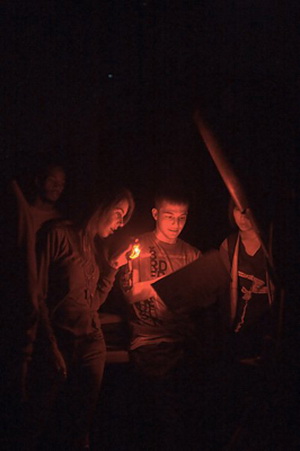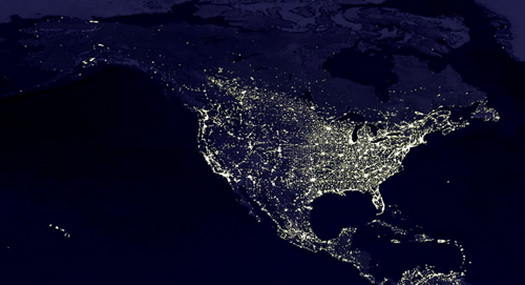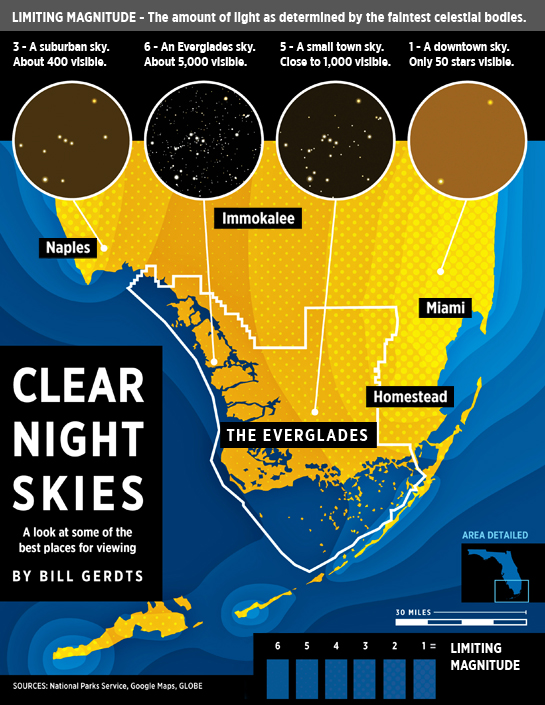
Everglades are ideal to view night sky
FLORIDA CITY, Fla. — It’s hard to forget the first time I looked up at the Everglades night sky.
Two years ago, my car had broken down around midnight on Alligator Alley, a highway that extends through the Florida Everglades. Stranded in darkness and waiting for a tow truck on the side of the road, I rested my head against the window and peered through it.
I looked up, facing the southern night sky—the direction towards Everglades National Park. My jaw dropped. What seemed like hundreds—no, thousands of stars were now shining above me. Was this the same sky I was looking at in nearby Miami hours earlier? I thought. The sight was a far contrast.
| Click on the video to see a slide show about night sky viewing in Everglades National Park created by writer Farah Dosani. |
In the past 120 years, people have witnessed the once black skies of night evolve into shades of gray. The lights of urban development wash out stars, planets, and other astronomical bodies from our view.
“It wasn’t too long ago, when [people] could look up and see an unspoiled sky,” said Chad Moore, manager of the National Park Service’s Night Sky Program.
Everglades National Park protects more than just threatened wildlife and natural habitat. It protects the darkness and integrity of night skies, a diminishing phenomenon in South Florida and the United States.
Fifteen miles east from the Everglades’ northwest border, people from Miami gather to observe the night sky in a county park not far from the city. A sign banning car headlights greets visitors as they walk toward the telescopes. Some peer through viewfinders, while others simply look up.
A young woman approaches Andrés Valencia, asking him to point out the Andromeda Galaxy. Valencia is a deep sky photographer and serves as educational outreach for the Southern Cross Astronomical Society (SCAS), the local group hosting the event. He searches the cosmos, first with the naked eye and then through telescopes. No luck.
“Tonight, the sky is brighter than Andromeda,” Valencia sighed.
 |
At left, University of Miami Astronomy Club members visit Everglades National Park to view the night sky through telescopes without light pollution (Photo courtesy of Stephen Seto). Next, thousands of stars are visible in the Everglades night sky (Photo courtesy of Michael Pancier). The moon and Venus provide natural light in the skies of Everglades National Park (Photo courtesy of Michael Pancier) Last, light pollution affects South Florida and most areas of the U.S. (Photo courtesy of NASA). |
The Everglades has become a popular refuge for night sky gazers trying to escape the rampant light pollution of nearby cities.
University of Miami’s Astronomy Club hosts monthly ‘Dark Sky Trips’ to the park’s Mahogany Hammock. The site is 20 miles from the Ernest Coe Visitor Center and attracts occasional stargazers to professional astronomers.
Several members exclaim “wow” as they open their car doors, step out into the park, and cock their heads back toward the sky.
“It’s pitch black and you have to use your cell phone to identify each other,” recalled Astronomy Club member Jeanne Leyton.
But, the darkness amplifies the visibility of the cosmos above. The club sets up telescopes to magnify constellations, galaxies and nebulas—among thousands of other objects in the sky.
“When I got out to the Everglades, I realized how bad the light pollution was,” said club member Eddie Prieto.
According to the National Park Service, 99 percent of the U.S. population lives in an area that scientists consider light polluted and two-thirds of Americans can no longer see the Milky Way from their backyard. Objects that were once easy to observe in the night sky have become increasingly elusive to most of the country.
The use of artificial light proliferated with the invention of the light bulb in 1879. The roots of light pollution, however, stem from the inefficient design of its fixtures: rather than just illuminating below them, light is often spilled up and sideways.
“There are a lot of street lights shining in all directions that don’t need to be,” said UM Astronomy Club President Stephen Seto. “There’s a lot of unnecessary over-lighting.”
The accumulation of such light creates a bright dome around the city. These effects are creeping into national parks and can be felt by wildlife and visitors alike.
“In the Everglades, light pollution looks like a distant glow very near the horizon,” said Valencia. “You don’t need a compass at night to know which direction is Miami.” Many compare the appearance of light pollution to dawn. Just like the early morning sun, the glare of urban areas erases stars along the horizon.
But, the effects of artificial light go beyond aesthetics. Increased concern has developed over its ecological consequences.
“More than half the species on earth are nocturnal,” said Night Sky Program Director Chad Moore. Light pollution disturbs predator-prey relationships to migration.
“Trees drop their leaves when the length of darkness reaches a certain point. Animals grow coats based on the length of the night. It’s the cadence of nature,” explained Moore. “With artificial light, we are disrupting…the most basic environmental cue that exists on our planet.”
Moore started the Night Sky Program in 1999 to address these concerns in national parks. Today, the program assesses night sky quality and monitors light pollution. Data have been collected on 76 parks to date, all of which have been in the southwestern region of the U.S.
“That’s where most of the dark skies still remaining are thought to be,” said Moore.
The program, however, plans to expand its research to the eastern parks in 2010. Everglades and Dry Tortugas national parks are among the ones that will be assessed.
Although the NPS has a policy within parks that prevents light pollution, the source of the problem remains in surrounding cities. Light from urban areas have shown to affect night skies over 200 miles away.
Several communities throughout the United States have established lighting ordinances on their own. The rationale behind them varies; some implement them for aesthetic purposes, while others do it to save energy. Some cities along the Florida coast enact these restrictions during sea turtle nesting.
But, Moore notes that tangible change requires mobilization on a much larger scale.
“If you want to save the night sky [in the Everglades], it’s going to be more than just a few communities,” said Moore. “It’s going to be entirely South Florida.”
Yet, light pollution is seen as one of the easier environmental issues to reverse.
“Consider every light under your control,” said Valencia. “Is it serving this reason well? Are you spilling this light up? Are you wasting energy? [Light pollution] is a problem that goes away by flipping a switch.”
And many stress the urgency and value in doing so.
Italy’s Light Pollution Science and Technology Institute estimated that a child born today has less than a one in 10 chance of ever experiencing a truly dark sky.
“What you consider a dark sky is not what your parents consider a dark sky,” said Moore. “Young people today don’t know about it. How can you know what you haven’t seen?”
Everglades National Park continues to function as a sanctuary for those escaping the artificial lights of the city to experience the true darkness of night.
In this remote spot, Andrés Valencia looks up at the cosmos despite the cloud cover, moonlight, and light pollution from nearby Miami. He says the loss of the dark skies would be a loss of human culture and perspective.
“We think that people tend to get kind of crazy when they can’t see the [night] sky, because it’s a peaceful sensation that you’re not alone—that you’re in the universe, there are many stars around you, and you’re not the only one there.”

Ways to Enjoy Natural Darkness in National Parks
The National Park Service recommends these approaches to enjoying the night skies:
- Try walking outside in a dark location while keeping your flashlight in your pocket.
- By covering your flashlight with red cellophane or a red filter, you can prevent it from disrupting your night vision. Small flashlights work better than large ones.
- Spend time looking through telescopes (stargazing) and learning about the cosmos with your local science center, astronomy club, or park ranger.
- The full moon provides ample light to see in most places. Let your eyes fully adjust. Be safe. A full moon hike will be a memorable experience.
- Find a comfortable spot and look around. Allow your eyes 20 minutes to adjust, and you may be surprised how well you can see by starlight. Do objects appear further? Listen. Do sounds seem louder at night?
- Many animals live their “days” at night. Look for nocturnal wildlife such as owls, bats, deer, glowworms, or fireflies.
- The night sky has been an inspiration for myth, literature, art, scientific discovery, and religion. Find your own way to connect with humankind’s celestial companion. Revel in its beauty and wonder, and most of all – be inspired!

Information graphic designed and prepared by Bill Gerdts.

Comments are Closed